Variants of Orthodox crosses. What should be a pectoral Orthodox cross? (Photo)
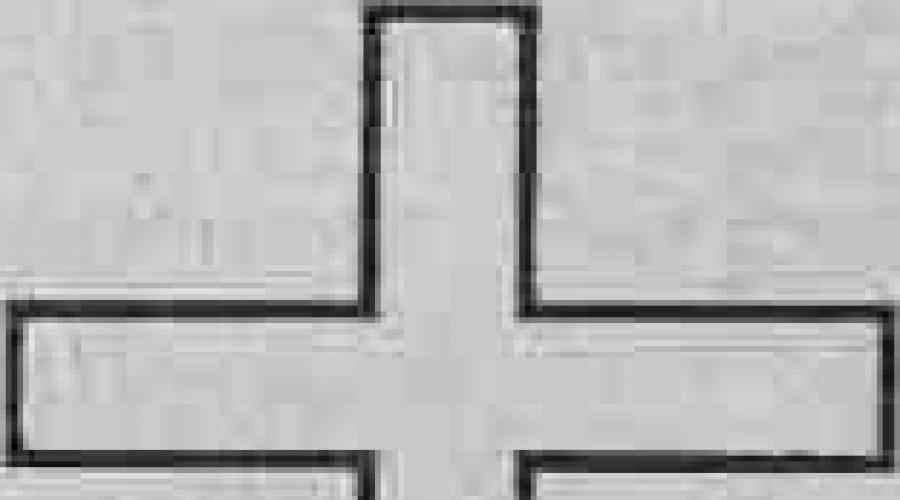
There are a great many forms and types of crosses. Historically, some of them have acquired special meaning, due to the specific symbolism contained in them.
Symbols and meaning Orthodox crosses.
Eight-pointed cross
The eight-pointed cross is the most common in Russia. Above the middle crossbar of this cross, which is longer than the others, there is a straight short crossbar, and under the middle crossbar there is a short oblique crossbar, the upper end is directed to the north, the lower - to the south.
The upper small crossbar symbolizes a plaque with an inscription made by order of Pilate in three languages, and the lower one - the foot on which the Savior's feet rested, depicted in reverse perspective.
The form of this Cross corresponds most of all to the Cross on which Christ was crucified. Therefore, such a Cross is no longer only a sign, but also the image of the Cross of Christ. The upper crossbar is a sign with the inscription “Jesus Nazarene Tsar Jewish ”, nailed by Pilate's order over the head of the Crucified Savior. The lower crossbar is a footrest designed to increase the torment of the Crucified, since the deceptive feeling of some support under the feet prompts the executed person to involuntarily try to relieve his weight by leaning on it, which only prolongs the torment itself. Dogmatically, the eight points of the Cross represent eight major periods in the history of mankind, where the eighth is the life of the century to come, the Kingdom of Heaven, why one of the ends of such a Cross points up to the sky. It also means that the path to the Heavenly Kingdom is opened by Christ through His Redeeming Feat, according to His word: “I am the way and the truth and the life” (John 14: 6). The oblique crossbar, to which the Savior's feet were nailed, thus means that in the earthly life of people with the coming of Christ, who walked the earth with a sermon, disrupted the balance of all people, without exception, under the power of sin. The world has begun new process spiritual rebirth of people in Christ and their removal from the area of darkness into the area of heavenly light. It is this movement of saving people, raising them from earth to heaven, corresponding to the feet of Christ as the organ of movement of a person making his own way, and denotes the oblique crossbar of the eight-pointed Cross. When the crucified Lord Jesus Christ is depicted on the eight-pointed Cross, the Cross as a whole becomes in full The crucifixion of the Savior and therefore contains in itself all the fullness of the power contained in the suffering of the Lord on the cross, the mysterious presence of Christ crucified. This is a great and terrible shrine. There are two main types of images of the crucified Savior. The ancient view of the Crucifixion depicts Christ stretching his arms wide and straight along the transverse central crossbar: the body does not sag, but rests freely on the Cross. The second, later view, depicts the Body of Christ sagging, arms raised up and to the sides. The second type presents to the gaze the image of our Christ's suffering for the sake of salvation; here you can see the human body of the Savior suffering in torture. But such an image does not convey the entire dogmatic meaning of these sufferings on the cross. This meaning is contained in the words of Christ Himself, who told his disciples and the people: “When I am lifted up from the earth, I will draw everyone to Me” (John 12:32). The first, ancient type of the Crucifixion just reveals to us the image of the Son of God ascended to the Cross, stretching out his arms in an embrace, into which the whole world is called and attracted. Preserving the image of Christ's suffering, this kind of Crucifixion at the same time surprisingly accurately conveys the dogmatic depth of its meaning. Christ in His Divine love, over which death has no power and which, while suffering, and does not suffer in the usual sense, stretches out its arms to people from the Cross. Therefore, His Body does not hang, but solemnly rests on the Cross. Here Christ, crucified and dead, miraculously lives inhis death. This deeply corresponds to the dogmatic consciousness of the Church. The attractive embrace of Christ's arms embraces the entire Universe, which is especially well represented on the ancient bronze Crucifixes, where the Holy Trinity is depicted above the head of the Savior, at the upper end of the Cross, or God the Father and God the Holy Spirit in the form of a dove, in the upper short crossbar - those who clung to Christ angelic ranks; at the right hand of Christ the sun is depicted, and at the left - the moon; on the slanting crossbar at the Savior's feet is depicted the view of the city as an image of human society, those cities and towns along which Christ walked, preaching the Gospel; at the foot of the Cross is depicted the resting head (skull) of Adam, whose sins Christ washed with His Blood, and even below, under the skull, is depicted that tree of the knowledge of good and evil, which brought death to Adam and in it all his descendants and to which the tree of the Cross is now opposed, which gives life to itself and gives eternal life to people. Coming in the flesh into the world for the sake of the feat of the cross, the Son of God mysteriously embraces with Himself and penetrates with Himself all areas of being Divine, heavenly and earthly, fulfills with Himself all creation, the entire universe. Such a Crucifixion with all its images reveals symbolic meaning and the meaning of all the ends and crossbars of the Cross, helps to understand the many interpretations of the Crucifixion, which are kept by the holy fathers and teachers of the Church, makes it clear spiritual meaning those types of the Cross and Crucifixion, which do not have such detailed images. In particular, it becomes clear that the upperthe end of the Cross marks the realm of the existence of God, where God dwells in Trinity unity. The separation of God from creation is represented by the short upper crossbar. She, in turn, marks the area of heavenly existence (the world of angels). The middle long bar contains the concept of all creation in general, since here the sun and the moon are placed at the ends (the sun - as an image of the glory of the Divine, the moon - as an image the visible world who receives his life and light from God). Here the hands of the Son of God are stretched out, through whom everything “began to be” (John 1: 3). Hands embody the concept of creation, the creation of visible forms. There is a slanting crossbar beautiful image of humanity, called to ascend, to make its way to God. The lower end of the Cross marks the earth, previously cursed for the sin of Adam (see: Genesis 3:17), but now reunited with God by the exploit of Christ, forgiven and purified by the Blood of the Son of God. Hence, the vertical stripe of the Cross means unity, the reunification in God of all that exists, which was realized by the exploit of the Son of God. At the same time, the Body of Christ, voluntarily devoted for the salvation of the world, fulfills with itself everything - from the earthly to the sublime. This contains the incomprehensible mystery of the Crucifixion, the mystery of the Cross. What is given to us to see and understand in the Cross only brings us closer to this mystery, but does not reveal it.The cross has many meanings from other spiritual points of view. For example, in the Economy about the salvation of the human race, the Cross means by its vertical straight line the justice and immutability of the Divine commandments, the directness of God's righteousness and truth, which does not allow any violations. This straightforwardness is crossed by the main crossbar, meaning the love and mercy of God for the fallen and falling sinners, for the sake of which the Lord Himself was sacrificed, who took the sins of all people upon Himself.In the personal spiritual life of a person, the vertical line of the Cross means the sincere striving of the human soul from earth to God. But this striving is crossed by love for people, for neighbors, which, as it were, does not give a person the opportunity to fully realize his vertical striving for God. At certain stages of spiritual life, this is sheer torment and a cross for the human soul, well known to everyone who tries to walk the path spiritual feat... This is also a mystery, for a person must constantly combine love for God with love for his neighbors, although this is far from always it turns out from him. Many wonderful interpretations of the different spiritual meanings of the Cross of the Lord are contained in the works of the holy fathers.
Seven-pointed cross
The seven-pointed cross has one upper bar and an oblique foot. The foot, as part of the redemptive cross, has a very deep mystical and dogmatic meaning. Before the coming of Christ, the Old Testament priests sacrificed on a gold pedestal attached to the throne. The throne, as now among Christians, was sanctified through Confirmation: “and anoint them,” the Lord said, “... the altar of burnt offering and all its utensils ... and its footstool; and sanctify them, and there will be a shrine great: everything that touches them will be sanctified. " (Ex. 30, 26.28- 29).
This means that the foot of the cross is that part of the New Testament altar, which mystically points to the priestly ministry of the Savior of the world, who voluntarily paid with His death for the sins of others. “On the cross, He fulfilled the office of a Priest, who sacrificed Himself to God and the Father for the redemption of the human race,” we read in the “Orthodox Confession of the Eastern Patriarchs”. The foot of the Holy Cross reveals one of its mysterious sides. Through the lips of the prophet Isaiah, the Lord says: “I will glorify the footstool of my feet” (Isa. 60, 13). And David says in Psalm 99: “Exalt the Lord God ours, and worship His footstool; it is holy! "This means that we must worship the foot of the Holy Cross, sacredly honor it as “the foot of the New Testament sacrifice” (see: Ex. 30, 28).The seven-pointed cross can often be seen on the icons of northern writing. In the Historical Museum such a cross is depicted on the image of Paraskeva Friday with his life, on the image of St. Demetrius of Thessalonica in the Russian Museum, as well as on the icon "Crucifixion" dating from 1500and belonging to the brush of the icon painter Dionysius.Seven-pointed crosseserected on the domes of Russian churches. Such a cross rises above the entrance of the Resurrection Cathedral of the New Jerusalem Monastery.
Six-pointed cross
The six-pointed cross with an inclined lower crossbar is one of the ancient Russian crosses. For example, the worship cross, erected in 1161 by the Monk Euphrosyne, Princess of Polotsk, was six-pointed. Why is the bottom bar of this cross tilted? The meaning of this image is symbolic and very deep.
The cross in the life of every person serves as a measure, as if the scales of his inner
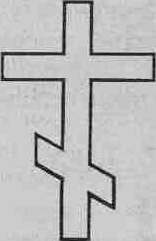 state, soul and conscience. So it was at the hour when the Lord was crucified on the Cross in the midst of two robbers. One, repented, entered the Kingdom of Heaven with the Lord, the other, embittered and hardened in sins, went to Hell. The slanting bar is symbolic and indicates two paths possible for a person.
state, soul and conscience. So it was at the hour when the Lord was crucified on the Cross in the midst of two robbers. One, repented, entered the Kingdom of Heaven with the Lord, the other, embittered and hardened in sins, went to Hell. The slanting bar is symbolic and indicates two paths possible for a person.
Why is the top bar missing? The fact is that, according to the Gospel, it is just a tablet ("titulus"), inscribed and placed on the cross by Pontius Pilate. That is, it can also be considered an "overhead element" that is not part of the cross itself. In addition, we do not know anything about the width of the "titulus": perhaps it was already a "pillar". Writes about this Saint Righteous John Kronstadt in his book "On the Cross of Christ".
Quadruped "drop-shaped" cross
 The teardrop-shaped cross has long been one of the favorite and widespread forms of the cross among Christians. The Savior sprinkled His blood on the tree of the cross, forever giving the cross His strength. The drops of blood of the Lord who redeemed us symbolize round drops in the half-arches of the four ends of the drop-shaped cross.
The teardrop-shaped cross has long been one of the favorite and widespread forms of the cross among Christians. The Savior sprinkled His blood on the tree of the cross, forever giving the cross His strength. The drops of blood of the Lord who redeemed us symbolize round drops in the half-arches of the four ends of the drop-shaped cross.
There were pectoral crosses of this form (as an element of the rosary) and breast crosses. The teardrop-shaped cross was often used to decorate liturgical books. In the Russian state the library contains the Greek Gospel XI century, whose title is adorned with a delicately executed teardrop-shaped cross.
Cross "Shamrock"

Symbols and varieties of ancient crosses.
T-shaped cross, "Antonievsky"
This three-pointed cross has come down to us since ancient times. They crucified on such a cross, carried out executions in Old Testament times, and already in the time of Moses such a cross was called “Egyptian.” Such a cross served as an instrument of execution in the Roman Empire. The cross consisted of two bars in the shape of the Greek letter “T” (tau). The Epistle of Barnabas contains an excerpt from the book of the prophet Ezekiel, where the T-shaped cross is typified as a symbol of righteousness: , make a sign. " Here, the word "sign" translates the name of the letter of the Hebrew alphabet "tav" (that is, the literal translation would be: "make tav"), corresponding to the Greek and Latin letter T.
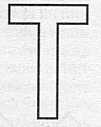
The author of “The Epistle of Barnabas”, referring to the book of Genesis (see: Gen. 14, 14), where it is said that the number of men of the house of Abraham, circumcised as a sign of the Covenant with God, was 318, reveals the transformative meaning of this event. 318 = 300 + 10 + 8, while 8 was denoted in Greek numbering by the letter "pi", 10 - by the letter "I", with which the name of Jesus begins; 300 was designated by the letter "T", which, in his opinion, indicates the expiatory meaning of the T-shaped cross. Also Tertullian writes: "The Greek letter tau. and our Latin T is the image of the cross ”. According to legend, this very cross was worn by the Monk Anthony the Great on his robes, which is why it is called “Antony's”. Saint Zeno, bishop of the city of Verona, erected a T-shaped cross on the roof of the basilica he built in 362.
Cross "Andreevsky"
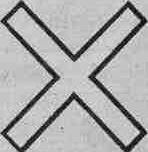 The image of this cross is already found in Old Testament... Prophet Moses, by the inspiration and action of God, took copper, made the image of the cross and told the people: “If you look at this image and believe, you will be saved through it” (see: Num. 21, 8; John 8). Greek letter cross X (who also hides the name of Christ) is called "Andreevsky" because it was on such a cross that the Apostle Andrew the First-Called was crucified. In 1694year, Emperor Peter the Great ordered to place the image of St. Andrew's cross on the naval flag, which since then has been called the "St. Andrew's" flag.
The image of this cross is already found in Old Testament... Prophet Moses, by the inspiration and action of God, took copper, made the image of the cross and told the people: “If you look at this image and believe, you will be saved through it” (see: Num. 21, 8; John 8). Greek letter cross X (who also hides the name of Christ) is called "Andreevsky" because it was on such a cross that the Apostle Andrew the First-Called was crucified. In 1694year, Emperor Peter the Great ordered to place the image of St. Andrew's cross on the naval flag, which since then has been called the "St. Andrew's" flag.
Schematic cross, or "Golgotha"
At the time of Jesus Christ, criminals sentenced to death on the cross were forced to carry this weapon themselves to the Execution Ground. And the Savior of the world was executed as a criminal. He carried his heavy cross to Calvary Himself. The death of Christ on the cross gave the cross of Calvary the glory of all time. He becamea symbol of the uprising from the dead and finding eternal life in the Kingdom of Jesus Christ, the greatest symbol of power and the power of Christ. ![]() Since XI century, this eight-pointed cross under the lower oblique crossbar has a symbolic image of the head of Adam. According to legend, it was on Golgotha, where Christ was crucified, that the forefather of mankind, Adam, was buried. V Xvicentury in Russia, near the image of Golgotha, the designations "M.L.R.B." - Place Forehead Crucified Byst(or, as they sometimes read: Place Skull Paradise Be) (Golgotha in Hebrew means Execution Ground). On the crosses “Golgotha” you can see other inscriptions “G. G." - Mount Golgotha, “G. A ”- Head of Adamov. On the images of Calvary, the bones of the hands lying in front ofhead, depicted right on left, as in burial or communion. The letters "K" and "T", depicted along the cross, mean a copy of the centurion Longinus and a cane with a sponge. The Calvary Cross stands on the steps that symbolize the path of Christ to Calvary. In total, three steps are depicted, they denote faith, hope and love. Lettering “IC "" XC "- the name of Jesus Christ is placed above the middle crossbar, and under it is the word" Nika "- which means Winner. On or near the title - “SNB BZI Y "- God's Son. Sometimes the abbreviation “I.N.TS.I. " - Jesus of Nazareth the King of the Jews. Above the title we see the words “KING OF SLVY” - the King of Glory.The second name - "schematic" - this cross received because that such crosses are supposed to be embroidered on the vestments of the great and angelic schema - three crosses on the paraman and five on the doll - on the forehead, on the chest, on both shoulders and on the back.Another cross "Calvary" is also depicted on the burial shroud, which marks the preservation of the vows given at baptism.
Since XI century, this eight-pointed cross under the lower oblique crossbar has a symbolic image of the head of Adam. According to legend, it was on Golgotha, where Christ was crucified, that the forefather of mankind, Adam, was buried. V Xvicentury in Russia, near the image of Golgotha, the designations "M.L.R.B." - Place Forehead Crucified Byst(or, as they sometimes read: Place Skull Paradise Be) (Golgotha in Hebrew means Execution Ground). On the crosses “Golgotha” you can see other inscriptions “G. G." - Mount Golgotha, “G. A ”- Head of Adamov. On the images of Calvary, the bones of the hands lying in front ofhead, depicted right on left, as in burial or communion. The letters "K" and "T", depicted along the cross, mean a copy of the centurion Longinus and a cane with a sponge. The Calvary Cross stands on the steps that symbolize the path of Christ to Calvary. In total, three steps are depicted, they denote faith, hope and love. Lettering “IC "" XC "- the name of Jesus Christ is placed above the middle crossbar, and under it is the word" Nika "- which means Winner. On or near the title - “SNB BZI Y "- God's Son. Sometimes the abbreviation “I.N.TS.I. " - Jesus of Nazareth the King of the Jews. Above the title we see the words “KING OF SLVY” - the King of Glory.The second name - "schematic" - this cross received because that such crosses are supposed to be embroidered on the vestments of the great and angelic schema - three crosses on the paraman and five on the doll - on the forehead, on the chest, on both shoulders and on the back.Another cross "Calvary" is also depicted on the burial shroud, which marks the preservation of the vows given at baptism.
Monogram cross "pre-Constantine"
On the gravestones of the first centuries of Christianity, there is a monogram consisting of Greek initial letters in the name of Jesus Christ  Moreover, such monograms are drawn up by cross-combining them: namely, Greek letters“I” (iot) and"X"(hee). It turns out a symbol in the form of St. Andrew's cross, vertically crossed by a line. Specialist in liturgical theology Archimandrite Gabriel believes that such a monogram is a “hidden image of the cross.” Similar monograms were depicted later, in the post-Constantine period, the image of the pre-Constantine monogram can be seen, for example, on the vaults of the Archbishop's Chapel V century in Ravenna.
Moreover, such monograms are drawn up by cross-combining them: namely, Greek letters“I” (iot) and"X"(hee). It turns out a symbol in the form of St. Andrew's cross, vertically crossed by a line. Specialist in liturgical theology Archimandrite Gabriel believes that such a monogram is a “hidden image of the cross.” Similar monograms were depicted later, in the post-Constantine period, the image of the pre-Constantine monogram can be seen, for example, on the vaults of the Archbishop's Chapel V century in Ravenna.
Cross anchor

This symbol was first discovered by archaeologists on the Thessalonian inscription. IIIcentury. A.S. Uvarov in his book reports on the slabs discovered by archaeologists in the caves of the Pretextatus, on which there were no inscriptions, but only an image of a cruciform anchor. The ancient Greeks and Romans also used this symbol, but they attached a completely different meaning to it. For them, it was a symbol of hope for a lasting earthly Existence. For Christians, the anchor, cruciform in shape, has become a symbol of hope for strongthe great fruit of the cross - The Kingdom of Heaven, that the Church - like a ship - will deliver all worthy people to the quiet haven of eternal life.Everyone can “take up the present hope (that is, the cross), which for the soul is like a safe and strong anchor.” (Heb. B, 18 "-19). meaning, and there is our strong hope.
Cross "monogram of Constantine"
Greek historian of the Church Eusebius Pamphilus in the book “On Lifeblessed Constantine "testifies about how holy kingConstantine Equal to the Apostles had a dream: heaven and a sign onhim, and appeared to him Christ also commanded the king to make a banner likeseen in the sky, to use it to protect against the attack of enemies. Constantine, fulfilling the will of God, erected a banner. Eusebius Pamphilus, who saw it himself banner, left a description: “It had the following appearance: on a long, gold-covered spear there was a transverse yard, which formed the sign of the cross with the spear, and on it the symbol of the salutary name: two letters showed the name of Christ, and from the middle came out the letter "R".The tsar then wore such a monogram on his helmet. The Konstantinovskaya monogram stood on many coins of the Emperor Constantine and was generally quite widely used. We find her image on a bronze coin of the Emperor Decarius, minted in Lydia in the middle of the 3rd century, on many tombstones. A. S. Uvarov in his "Christian Symbolism" gives an example of such a monogram in the form of a fresco in the caves of St. Sixtus.
Catacomb cross, or "Sign of victory"
 The Holy Tsar Constantine testified about the miracle that happened to him on October 28, 312, when the Emperor Constantine marched with an army against Maxentius, who was imprisoned in Rome. “One day at noon hours of the day, when the sun began to lean towards the west, I I saw the sign of the cross, made up of light and lying in the sun, with the inscription “By this, conquer!” ”,- the holy Tsar Constantine testified.This spectacle amazed the emperor and the entire army, which beheld the miracle that had appeared. The miraculous phenomenon of the cross in broad daylight attested by many writers, contemporaries of the emperor. One of them is especially important - the confessor Artemy before Julian the Apostate, to whom, during interrogation, Artemy said: “Christ from above called Constantine when he waged a war against Maxentius, showing him at noon“ the sign of the cross, radiantly shining over the sun and star-shaped Roman letters, predicting his victory in the war. Having been there yourself we saw His sign and read the letters, saw him and the whole army: there are many witnesses to this in your army, if only you want to ask them ”(ch. 29). The cross was four-pointed, and this image of the cross, since God Himself showed the sign of the four-pointed cross in heaven, has become especially important for Christians. “In the catacombs and in general on ancient monuments four-pointed crosses are incomparably more common than any other form, ”says Archimandrite Gabriel in the“ Guide to the Liturgy. ”Emperor Constantine defeated Maxentius, who was doing criminal and wicked deeds in Rome, for the power of God was with him. So, the cross, which was the tool of the pagans shameful execution, became a sign of victory, the triumph of Christianity, an object of reverence and veneration.Since then, such crosses have been placed on contracts and signified a signature "worthy of all trust." This image also held together the acts and decisions of the councils. “We command every conciliar the act, which is confirmed by the sign of the Holy Cross of Christ, should be kept in this way and so it should be, as it is, ”reads one of the imperial decrees.
The Holy Tsar Constantine testified about the miracle that happened to him on October 28, 312, when the Emperor Constantine marched with an army against Maxentius, who was imprisoned in Rome. “One day at noon hours of the day, when the sun began to lean towards the west, I I saw the sign of the cross, made up of light and lying in the sun, with the inscription “By this, conquer!” ”,- the holy Tsar Constantine testified.This spectacle amazed the emperor and the entire army, which beheld the miracle that had appeared. The miraculous phenomenon of the cross in broad daylight attested by many writers, contemporaries of the emperor. One of them is especially important - the confessor Artemy before Julian the Apostate, to whom, during interrogation, Artemy said: “Christ from above called Constantine when he waged a war against Maxentius, showing him at noon“ the sign of the cross, radiantly shining over the sun and star-shaped Roman letters, predicting his victory in the war. Having been there yourself we saw His sign and read the letters, saw him and the whole army: there are many witnesses to this in your army, if only you want to ask them ”(ch. 29). The cross was four-pointed, and this image of the cross, since God Himself showed the sign of the four-pointed cross in heaven, has become especially important for Christians. “In the catacombs and in general on ancient monuments four-pointed crosses are incomparably more common than any other form, ”says Archimandrite Gabriel in the“ Guide to the Liturgy. ”Emperor Constantine defeated Maxentius, who was doing criminal and wicked deeds in Rome, for the power of God was with him. So, the cross, which was the tool of the pagans shameful execution, became a sign of victory, the triumph of Christianity, an object of reverence and veneration.Since then, such crosses have been placed on contracts and signified a signature "worthy of all trust." This image also held together the acts and decisions of the councils. “We command every conciliar the act, which is confirmed by the sign of the Holy Cross of Christ, should be kept in this way and so it should be, as it is, ”reads one of the imperial decrees.
Monogram cross "post-constant"
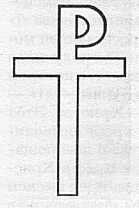 The cross - the monogram “post-Constantine” is a combination of the letters “T” (Greek “tav”) and “P” (Greek “ro”). The Greek word begins with the letter "P""Pax",meaning "King" and symbolizing the King-Jesus. The “P” is located above the “T” symbolizing His cross. United in this monogram, they remind together the words that all our strength and wisdom is in the Crucified King (see: 1 Cor. 1, 23-24).The apostles, preaching the Resurrection of the crucified Christ, called Jesus the King, honoring His origin from the royal dynasty of David, in contrast to the self-appointed and power-loving high priests who stole power over the people of God.Openly calling Christ the King, the Apostles suffered severe persecution from the clergy through the deceived people. Saint Justin interprets: "And this monogram served as a sign of the Cross of Christ." It became widespread a century later. "Monograms of Constantine" - inV century. The post-Constantine monogram is depicted in tomb of St. Callistus. It is also found on Greek slabs found in the city of Megara and on the gravestones of the cemetery of St. Matthew in Tire.
The cross - the monogram “post-Constantine” is a combination of the letters “T” (Greek “tav”) and “P” (Greek “ro”). The Greek word begins with the letter "P""Pax",meaning "King" and symbolizing the King-Jesus. The “P” is located above the “T” symbolizing His cross. United in this monogram, they remind together the words that all our strength and wisdom is in the Crucified King (see: 1 Cor. 1, 23-24).The apostles, preaching the Resurrection of the crucified Christ, called Jesus the King, honoring His origin from the royal dynasty of David, in contrast to the self-appointed and power-loving high priests who stole power over the people of God.Openly calling Christ the King, the Apostles suffered severe persecution from the clergy through the deceived people. Saint Justin interprets: "And this monogram served as a sign of the Cross of Christ." It became widespread a century later. "Monograms of Constantine" - inV century. The post-Constantine monogram is depicted in tomb of St. Callistus. It is also found on Greek slabs found in the city of Megara and on the gravestones of the cemetery of St. Matthew in Tire.
Monogram cross "sun-shaped"
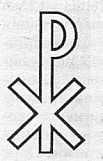 In IVcentury, Constantine's monogram has undergone a change: the letter was added to it"I"in the form of a line crossing the monogram across. This is how the sun-shaped cross turned out, in which three letters were connected -
"I"-Jesus and "XP" - Christ. This sun-shaped cross symbolizes fulfillment of the prophecy about the all-forgiving and all-conquering power of the Cross of Christ: “And for you, who revere my name, the Sun of righteousness and healing in His rays will rise” - this is how the Lord God proclaimed through the mouth of the prophet Malachi (Mal. 4, 2 ~ 3). And other words reveal to us the symbolism of the sun-shaped cross: “for the Lord God is the sun” (Psalm 84, 12).
In IVcentury, Constantine's monogram has undergone a change: the letter was added to it"I"in the form of a line crossing the monogram across. This is how the sun-shaped cross turned out, in which three letters were connected -
"I"-Jesus and "XP" - Christ. This sun-shaped cross symbolizes fulfillment of the prophecy about the all-forgiving and all-conquering power of the Cross of Christ: “And for you, who revere my name, the Sun of righteousness and healing in His rays will rise” - this is how the Lord God proclaimed through the mouth of the prophet Malachi (Mal. 4, 2 ~ 3). And other words reveal to us the symbolism of the sun-shaped cross: “for the Lord God is the sun” (Psalm 84, 12).
Cross "prosphora-konstantinovsky"
This cross, shaped like a "Maltese" cross, has Greek words on its four sides “
IC.XC. NIKA ”,which means "Jesus Christ is the Victor". The first time these words were written gold on three large cr 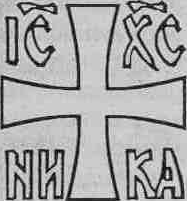 stakh in Constantinople as Equal to the Apostles Emperor Constantine ”. The Savior, the Conqueror of Hell and Death, says: “To him who overcomes I will give to sit with Me on My throne, as I overcame and sat down with my Father on his throne ”(Rev. 3:21). It is this cross with the addition of the words “ I S.Kh.S. NIKA" printed by ancient tradition, on prosphora.
stakh in Constantinople as Equal to the Apostles Emperor Constantine ”. The Savior, the Conqueror of Hell and Death, says: “To him who overcomes I will give to sit with Me on My throne, as I overcame and sat down with my Father on his throne ”(Rev. 3:21). It is this cross with the addition of the words “ I S.Kh.S. NIKA" printed by ancient tradition, on prosphora.
Monogram cross "Trident"
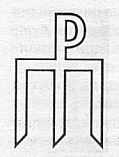
On ancient monument the sculptor Eutropius engraved an inscription saying that he was baptized. At the end of the inscription there is a trident monogram. What does this monogram symbolize? Passing near the Sea of Galilee, the Savior saw fishermen throwing their nets into the water, and said to them: “Follow Me, and I I will make you fishers of men ”(Matthew 4:19). Teaching the people with parables, Christ said: “like the Kingdom of Heaven is a net cast into the sea and seizedfish of every kind ”(Matthew 13:47).A. S. Uvarov in “Christian symbolism” indicates: “Recognizing in shells for fishing symbolic meaning Of the Kingdom of Heaven, we can assume that all the formulas related to this concept were iconically expressed by these symbols ”. And the trident, which used to catch fish, is also a symbol of the Kingdom of Heaven.Consequently, the trident monogram of Christ has long meant participation in the Sacrament of Baptism, as a trap in the network of God's Kingdom.
Crown of thorns cross
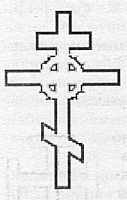
This cross is shaped like eight-pointed cross, the second crossbar of which is circled in the center with points along the edge, symbolizing a crown of thorns.When our forefather Adam sinned, the Lord said to him: “Cursed is the earth for you ... thorns and thistles it will grow for you” (Gen. 3, 17-18). And the new sinless Adam - Jesus Christ - voluntarily took upon himself the sins of others, and death, and thorns suffering leading to it.“The soldiers plaited a crown of thorns and put it on his head,” says the Gospel, “and by His stripes we are healed” (Isa. 53: 5). That is why the crown of thorns became for Christians a symbol of victory and reward, “a crown of righteousness” (2 Tim. 4, 8), “a crown glory ”(1 Pet. 5, 4),“ the crown of life ”(James 1, 12; Apoc. 2, 10).The cross with a crown of thorns was known among various Christian peoples of antiquity. When the Christian faith spread to other lands, these new Christians also accepted the “crown of thorns” cross.For example, a cross of this shape is depicted on the pages of the ancient Armenian handwritten book of the period of the Cilician kingdom. And in Russia the image of the cross "crown of thorns" was used. Such a cross is placed on the icon "Glorification of the Cross" XII century located in Tretyakov Gallery... The image of a cross with a crown of thorns is also embroidered on the “Calvary” cover - the monastic contribution of Queen Anastasia Romanova.
Hanging cross
This form of the cross is especially often used to decorate temples, church utensils, and holy vestments. Similar crosses, enclosed in a circle, are seen on holy vestments; we see them on the hierarchical homophores of the “three universal teachers”
Cross "vine" or "flourishing cross"
A cross with an inclined foot, and from the lower end, as it were, two stems twist upwards 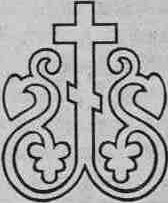 with leaves and a grape cluster on each. “I am the vine, and you are the branches; he who abides in Me, and I in him, the same bears much fruit ”(John 15: 5). Called himself a vine The Savior himself and since then this image has become deeply symbolic. The main meaning of the vine for Christians, - writes A. S. Uvarov, - was in a symbolic connection with the Sacrament of Communion. While partaking, we abide in the Lord, and He is in us, and then we receive a lot of “spiritual fruit” ”.
with leaves and a grape cluster on each. “I am the vine, and you are the branches; he who abides in Me, and I in him, the same bears much fruit ”(John 15: 5). Called himself a vine The Savior himself and since then this image has become deeply symbolic. The main meaning of the vine for Christians, - writes A. S. Uvarov, - was in a symbolic connection with the Sacrament of Communion. While partaking, we abide in the Lord, and He is in us, and then we receive a lot of “spiritual fruit” ”.
Petal cross
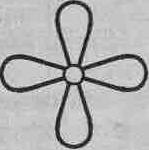 A four-pointed cross, the ends of which are created in the form of petals, and the middle that connects them looks like a round heart of a flower. Such a cross was worn on the omophorion by Saint Gregory the Wonderworker. The petal cross is most often used for decoration church buildings. We meet petal crosses, for example, in mosaics XI century Kiev Hagia Sophia.
A four-pointed cross, the ends of which are created in the form of petals, and the middle that connects them looks like a round heart of a flower. Such a cross was worn on the omophorion by Saint Gregory the Wonderworker. The petal cross is most often used for decoration church buildings. We meet petal crosses, for example, in mosaics XI century Kiev Hagia Sophia.
Greek cross
Greek cross - four-pointed, built by the perpendicular intersection of two  parts equal in length. These parts can be straight or have small extensions at the ends. The equality of the vertical and horizontal lines indicates the harmony of the heavenly and earthly world. The four-pointed, equilateral cross is the sign of the Cross of the Lord, dogmatically meaning that to the Cross of Christ is equalall ends of the universe, four cardinal points are called. This type of cross symbolizes the Church of Christ in the unity of the invisible and visible sides... The eyes of the invisible church are Christ. He leads the visible church, consisting of clergy and laity, priests and ordinary believers. All rituals and sacraments performed in the visible church gain strength through the action of the invisible church.The Greek cross was traditional for Byzantium and appeared at the same time as the “Latin” cross appeared in the Roman church, in which the vertical beam is longer than the horizontal one.The Greek cross is also considered the oldest Russian cross. According to church tradition, the holy prince Vladimir took out of Korsun, where he was baptized, just such a cross and installed it on the banks of the Dnieper in Kiev. Therefore his also called "Korsunsky". Such a cross is carved on the tomb of Prince Yaroslav the Wise in the Kiev Sophia Cathedral.Sometimes the "Greek cross" is depicted inscribed in a circle, symbolizing the cosmological sphere of heaven.
parts equal in length. These parts can be straight or have small extensions at the ends. The equality of the vertical and horizontal lines indicates the harmony of the heavenly and earthly world. The four-pointed, equilateral cross is the sign of the Cross of the Lord, dogmatically meaning that to the Cross of Christ is equalall ends of the universe, four cardinal points are called. This type of cross symbolizes the Church of Christ in the unity of the invisible and visible sides... The eyes of the invisible church are Christ. He leads the visible church, consisting of clergy and laity, priests and ordinary believers. All rituals and sacraments performed in the visible church gain strength through the action of the invisible church.The Greek cross was traditional for Byzantium and appeared at the same time as the “Latin” cross appeared in the Roman church, in which the vertical beam is longer than the horizontal one.The Greek cross is also considered the oldest Russian cross. According to church tradition, the holy prince Vladimir took out of Korsun, where he was baptized, just such a cross and installed it on the banks of the Dnieper in Kiev. Therefore his also called "Korsunsky". Such a cross is carved on the tomb of Prince Yaroslav the Wise in the Kiev Sophia Cathedral.Sometimes the "Greek cross" is depicted inscribed in a circle, symbolizing the cosmological sphere of heaven.
Latin four-pointed cross
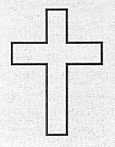
Four-pointed cross with an elongated bottom highlights the idea of the longsuffering of Divine love, which gave the Son of God as a sacrifice on the cross for the sins of the world. Such crosses first appeared in IIIcentury in the Roman catacombs, where Christians gathered for divine services. Crosses of this shape were as common as the Greek ones. The variety of forms of the cross was recognized by the Church quite natural. According to the expression of the Monk Theodore the Studite, "... a cross of every form is a true cross." “By a variety of sensory signs, we are hierarchically elevated to a uniform union with God” (John Damascene). A cross of this shape is still used by some Eastern Orthodox Churches.The stance of this cross is much longer than the beam. The post and beam intersect so that the two horizontal arms and the upper vertical portion are the same length. Bottom part the rack is two-thirds of the total length. This cross primarily symbolizes the suffering of Christ the Savior. A strong impetus for the veneration of the direct image of the cross,and not monogrammed, was the acquisition of the Honest Of the Life-giving Cross mother of the holy Tsar Constantine, Equal to the Apostles Helen. As the direct image of the cross spreads, it gradually acquires the form of the Crucifixion.In the Christian West, such a cross is the most common. Often zealous devotees of the eight-limbed do not recognize the Latin cross. Old Believers, for example, call it dismissively "latin kryzh" or "rimski kryzh", which means the Roman cross. But we must not forget that, as it is written in the Gospel, the execution of the godmother spread throughout the Empire by the Romans and was considered Roman. “Honorable cross, four-pointed power, splendor to the apostles ", - is sung in the" Canon Honest Cross”St. Gregory the Sinaite. The divine power of the Cross containseverything earthly, heavenly and hell. “Behold the four-pointed Cross, had height, depth and breadth,” is sung in the fourth canon of the canon.Saint Demetrius of Rostov says: “... Not according to the length of the tree, not according to the number In the end, the Cross of Christ is revered by us, but according to Christ himself, with whose holy blood he was stained red. Showing miraculous power, any Cross does not work by itself, but by the power of Christ crucified on it and the invocation of His holy name ”.
Cross "Lorenz" or "Russian patriarchal"
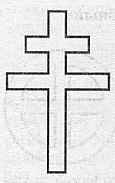 In shape, it is a six-pointed cross, with the upper crossbar parallel to the lower one, but shorter than it. The “Patriarchal Cross” has been used since the middle of the last millennium. It is this form six-pointed cross was depicted on the seal of the governor of the Byzantine emperor in the city of Korsun. Such a cross was worn by the Monk Avraamy of Rostov. Such a cross was widespread in the Christian West - it is called there "Loren".
In shape, it is a six-pointed cross, with the upper crossbar parallel to the lower one, but shorter than it. The “Patriarchal Cross” has been used since the middle of the last millennium. It is this form six-pointed cross was depicted on the seal of the governor of the Byzantine emperor in the city of Korsun. Such a cross was worn by the Monk Avraamy of Rostov. Such a cross was widespread in the Christian West - it is called there "Loren".
Cross "papal"
 This form of an eight-pointed cross has three bars, of which the top and bottom are the same size, smaller than the middle. The lower crossbar, or foot, at this cross is located not obliquely, but at a right angle. Why the foot is depicted at a right angle, and not the way it is on the eight-pointed Orthodox, let us answer with the words of St. Demetrius of Rostov: “I kiss the foot of the cross, even if it is oblique, if not oblique, and the custom of cross-makers and cross-writers, as consistent with the church, I do not dispute, I indulge”.
This form of an eight-pointed cross has three bars, of which the top and bottom are the same size, smaller than the middle. The lower crossbar, or foot, at this cross is located not obliquely, but at a right angle. Why the foot is depicted at a right angle, and not the way it is on the eight-pointed Orthodox, let us answer with the words of St. Demetrius of Rostov: “I kiss the foot of the cross, even if it is oblique, if not oblique, and the custom of cross-makers and cross-writers, as consistent with the church, I do not dispute, I indulge”.
Round "freebie" cross
 Once upon a time, long before the coming of Christ, there was a custom in the East to cut bread crosswise. It was a symbolic act, which meant that the cross, dividing the whole into parts, unites those who used these parts, heals separation.According to the testimony of Horace and Martial, the early Christians cut round bread crosswise to make it easier to break it. In direct connection with the Sacrament of Communion, bread was depicted on chalice, felonies and other things as a symbol of the Body of Christ, broken for our sins. Such round loaves, divided into four parts by a cross, are depicted in the Sintofion inscription. Breads divided by six parts, available on the tombstone from the cave of St.Lukin(III century). The circle means, according to the explanation of St. Clement of Alexandria, that "the Son of God Himself is an endless circle, in which all forces converge."
Once upon a time, long before the coming of Christ, there was a custom in the East to cut bread crosswise. It was a symbolic act, which meant that the cross, dividing the whole into parts, unites those who used these parts, heals separation.According to the testimony of Horace and Martial, the early Christians cut round bread crosswise to make it easier to break it. In direct connection with the Sacrament of Communion, bread was depicted on chalice, felonies and other things as a symbol of the Body of Christ, broken for our sins. Such round loaves, divided into four parts by a cross, are depicted in the Sintofion inscription. Breads divided by six parts, available on the tombstone from the cave of St.Lukin(III century). The circle means, according to the explanation of St. Clement of Alexandria, that "the Son of God Himself is an endless circle, in which all forces converge."
Nakupolny cross with a crescent
Four-pointed cross with a semicircle in the form of a crescent below, where the ends of the crescent  facing upwards - a very ancient form of the Cross. Most often, such crosses were placed and are being erected on the domes of temples. The cross and the semicircle mean the anchor of salvation, the anchor of our hopes, an anchor of repose in the harbor of the Heavenly Kingdom, which is very consistent with the concept of a temple as a ship sailing to the Kingdom of God.There are other interpretations of this symbol: the crescent moon is the Eucharistic cup in which the Body of Christ is located; this is cradle in which the baby Jesus Christ lies.According to another interpretation, the moon marks the font in which the Church, baptized into Christ, is clothed in Him, in the Sun of Truth. Sometimes one has to hear and read an explanation of such a form as "the victory of the cross over the crescent", that is, "the victory of Christianity over Islam." This is completely unfounded, since this form of the cross was known long before the advent of the Muslim faith.
facing upwards - a very ancient form of the Cross. Most often, such crosses were placed and are being erected on the domes of temples. The cross and the semicircle mean the anchor of salvation, the anchor of our hopes, an anchor of repose in the harbor of the Heavenly Kingdom, which is very consistent with the concept of a temple as a ship sailing to the Kingdom of God.There are other interpretations of this symbol: the crescent moon is the Eucharistic cup in which the Body of Christ is located; this is cradle in which the baby Jesus Christ lies.According to another interpretation, the moon marks the font in which the Church, baptized into Christ, is clothed in Him, in the Sun of Truth. Sometimes one has to hear and read an explanation of such a form as "the victory of the cross over the crescent", that is, "the victory of Christianity over Islam." This is completely unfounded, since this form of the cross was known long before the advent of the Muslim faith.
Cross "Maltese", or "St. George"
The handle of the bishop's baton is decorated with a cross called the "Maltese" or "St. George" cross. Patriarch James prophetically honored the Cross when “by faith ... he bowed down,” as the Apostle Paul says, “on the top of his rod” (Heb. 11, 21). And Saint John Damascene explains: "A rod that served as an image of the cross." Therefore, the cross rises above the bishop's rod.In addition to the usual and widespread church use, the form of this cross was officially adopted formed on the island of Malta by the Order of St. John of Jerusalem. After that, the cross itself began to be called "Maltese". And the name "St. George" was given to this cross with the establishment of the award sign - the Cross of St. George Victorious.Golden "Maltese" crosses were included in the coats of arms of many Russian cities.
Old printed cross "braided"
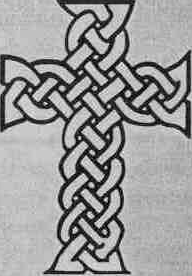
The very name of this cross contains basic information about it; its entire surface consists of various weaving elements. Weaving as a species decorative arts existed already in ancient Christian times. It is known in embroidery, stone and wood carving, as well as in mosaics, but images of wicker crosses are especially common in decorating handwritten and early printed books. This cross shape is often found as decoration in Bulgarian and Russian old printed books.
Cross "curved"
 The cross, consisting of flowers of the field lily, in Slavic called "krin selyny", bears the name of the "curved" cross. This cross arose as a reminder of In the words of the Savior: "I," said the Lord, "... the lily of the valleys!" (Song. 2.1). Ancient philosopher and the writer Origen writes about Christ: “For the sake of me, who is down, He descends into the valley, and when he comes into the valley, He becomes a lily. Instead of the tree of life, which was planted in the paradise of God, He became the flower of the whole field, that is, the whole world and all the earth. "Curved crosses were widely used in Byzantium. In Russia, pectoral crosses of this form were worn. In the book “Russian copper casting ”contains images of crosses with curved ends XI-XII centuries.
The cross, consisting of flowers of the field lily, in Slavic called "krin selyny", bears the name of the "curved" cross. This cross arose as a reminder of In the words of the Savior: "I," said the Lord, "... the lily of the valleys!" (Song. 2.1). Ancient philosopher and the writer Origen writes about Christ: “For the sake of me, who is down, He descends into the valley, and when he comes into the valley, He becomes a lily. Instead of the tree of life, which was planted in the paradise of God, He became the flower of the whole field, that is, the whole world and all the earth. "Curved crosses were widely used in Byzantium. In Russia, pectoral crosses of this form were worn. In the book “Russian copper casting ”contains images of crosses with curved ends XI-XII centuries.
Cross-monogram "shepherd's staff"
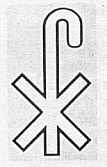
Christians consider the rod of Moses to be the prototype of the Cross of Christ. The Lord gave the staff of Moses miraculous power as a sign of pastoral authority. The prophet Moses divided and united the waters of the Black Sea with the image of the cross.The Lord, through the mouth of the prophet Micah, says to His Only Begotten Son: "Feed Thy people with Thy rod with Thy rod, the sheep of Thy inheritance." The symbol "shepherd" is depicted by the early Christians in the form of a bent staff, which crosses the letter“X”, which has two meanings - the vertical rack of the cross and the first letter of the name of Christ. A. S. Uvarov, describing the finds of the Catacomb period with such an image, calls them “the monogram of the Savior”.
Cross in the form of the Egyptian hieroglyph "ankh"
 Cross shaped Egyptian hieroglyph“Ankh” is one of the oldest used by Christians. As you know, hieroglyphs do not denote letters, but concepts. The hieroglyph "ankh" means the concept of "life". Christians call the cross life-giving. Christian cross- the tree of Life. “He who found me found life,” Christ announced through the mouth of the king the prophet Solomon! (Proverbs 8.35) and after His incarnation repeated: “II am the resurrection and the life ”(John 11:25). To depict the life-giving cross, Christians from the first centuries used the hieroglyph "ankh", which resembles it in form and means "life".
Cross shaped Egyptian hieroglyph“Ankh” is one of the oldest used by Christians. As you know, hieroglyphs do not denote letters, but concepts. The hieroglyph "ankh" means the concept of "life". Christians call the cross life-giving. Christian cross- the tree of Life. “He who found me found life,” Christ announced through the mouth of the king the prophet Solomon! (Proverbs 8.35) and after His incarnation repeated: “II am the resurrection and the life ”(John 11:25). To depict the life-giving cross, Christians from the first centuries used the hieroglyph "ankh", which resembles it in form and means "life".
Cross "gamma"
 This cross is called “gammatic” because it consists of the Greek letter “gamma”. Already the first Christians in the Roman catacombs depicted a gamma cross. In Byzantium, this form was often used to decorate the Gospels, church utensils, temples, embroidered on the vestments of the Byzantine hierarchs. V IX century, by order of Empress Theodora, a Gospel was made, decorated with gold ornamentation from gamma crosses. The book "Matenadaran" depicts a four-pointed cross surrounded by twelve gamma crosses.
And in Russia the form of this cross has long been used. He is depicted on many church objects of the pre-Mongol period, in the form of a mosaic under the dome of the Cathedral of St. Sophia of Kiev, in the ornament of the doors of the Nizhny Novgorod Cathedral... Gammatic crosses are embroidered on a phelonion from the Moscow Church of St. Nicholas in Pyzhy.The gamma cross used toput on their things, as a sign bringing happiness, the holy martyr Empress Alexandra Feodorovna. The Holy Empress drew such a cross with a pencil in the Ipatiev house over her son's bed and on the doorframe on the day the Royal Family arrived in Yekaterinburg.
This cross is called “gammatic” because it consists of the Greek letter “gamma”. Already the first Christians in the Roman catacombs depicted a gamma cross. In Byzantium, this form was often used to decorate the Gospels, church utensils, temples, embroidered on the vestments of the Byzantine hierarchs. V IX century, by order of Empress Theodora, a Gospel was made, decorated with gold ornamentation from gamma crosses. The book "Matenadaran" depicts a four-pointed cross surrounded by twelve gamma crosses.
And in Russia the form of this cross has long been used. He is depicted on many church objects of the pre-Mongol period, in the form of a mosaic under the dome of the Cathedral of St. Sophia of Kiev, in the ornament of the doors of the Nizhny Novgorod Cathedral... Gammatic crosses are embroidered on a phelonion from the Moscow Church of St. Nicholas in Pyzhy.The gamma cross used toput on their things, as a sign bringing happiness, the holy martyr Empress Alexandra Feodorovna. The Holy Empress drew such a cross with a pencil in the Ipatiev house over her son's bed and on the doorframe on the day the Royal Family arrived in Yekaterinburg.
There are a lot of types of crosses and very many already know what to do with a pectoral cross and how to wear it correctly. Therefore, first of all, the question arises as to which of them are related to Orthodox faith, and which - to the Catholic.
In both forms Christian religion there are several types of crosses, in which it is necessary to understand so as not to be confused.
The main differences between the Orthodox cross
has three transverse lines: the upper and lower lines are short, between them is long;at the ends of the cross, three semicircles can be decorated, resembling a trefoil;
on some Orthodox crosses below, instead of an oblique transverse line, there may be a month - this sign came from Byzantium, from which Orthodoxy was adopted;
Jesus Christ was crucified at his feet with two nails, while on Catholic crucifixion- one nail;
there is some naturalism on the Catholic crucifixion, which reflects the torment of Jesus Christ, which he endured for people: the body looks literally heavy and hangs down on his hands. Orthodox crucifixion shows the triumph of God and the joy of the Resurrection, the overcoming of death, so the body is, as it were, imposed on top, and does not hang on the cross.
Catholic crosses
First of all, these include the so-called Latin cross. Like everything, it is a vertical and horizontal line, while the vertical is noticeably longer. Its symbolism is as follows: this is how the cross that Christ carried to Golgotha looked like. Previously, it was also used in paganism. With the adoption of Christianity, the Latin cross became a symbol of faith and is sometimes associated with opposite things: with death and resurrection. Another similar cross, but with three transverse lines, is called papal. It relates only to the Pope and is used in ceremonies.There are also many types of crosses used by all sorts of knightly Orders, such as the Teutonic or Maltese. Since they were subordinate to the Pope, these crosses can also be considered Catholic. They look slightly different from each other, but what they have in common is that their lines taper noticeably towards the center.
The Lorraine cross is very similar to the previous one, but it has two crossbars, and one of them may be shorter than the other. The name indicates the area in which this symbol appeared. The Cross of Lorraine appears on the coats of arms of cardinals and archbishops. Also, this cross is a symbol of the Greek Orthodox Church, therefore it cannot be fully called Catholic.
Orthodox crosses
Faith, of course, implies that the cross must be worn constantly and not taken off, except in the most rare situations. Therefore, it is necessary to choose it with understanding. The most widely used cross in Orthodoxy is the eight-pointed cross. It is depicted as follows: One vertical line, a large horizontal line just above the center and two more shorter crossbars: above and below it. In this case, the lower one is always inclined and its right part is at a level below the left.The symbolism of this cross is as follows: it already shows the cross on which Jesus Christ was crucified. The upper transverse line corresponds to the nailed crossbar with the inscription "Jesus of Nazareth, King of the Jews." According to biblical tradition, the Romans joked about him after they had already been crucified on the cross and awaited his death. The crossbar symbolizes the one to which Christ's hands were nailed, and the lower one - where his legs were chained.
The inclination of the lower bar is explained as follows: together with Jesus Christ, two thieves were crucified. According to legend, one of them repented before the Son of God and then received forgiveness. The second one began to scoff and only aggravated his situation.
However, the first cross that was first brought from Byzantium to Russia was the so-called Greek cross. He, like the Roman, is four-pointed. The difference is that it consists of the same rectangular bars and is completely isosceles. It served as the basis for many other types of crosses, including the crosses of the Catholic orders.
Other types of crosses
St. Andrew's Cross is very similar to the letter X or an inverted Greek cross. It is believed that it was on this that the Apostle Andrew the First-Called was crucified. Used in Russia on the flag of the Navy. He is also featured on the flag of Scotland.The Celtic cross is also similar to the Greek one. He is necessarily taken in a circle. This symbol has been used for a very long time in Ireland, Scotland and Wales, as well as parts of Britain. At a time when Catholicism was not widespread, Celtic Christianity prevailed in this area, which used this symbol.
During Baptism, each person is dressed pectoral cross... For the rest of your life, it must be worn on your chest. Believers note that the cross is not a talisman or dyeing. This is a symbol of commitment to the Orthodox faith and God. He helps in difficulties and troubles, strengthens the spirit. When wearing a cross, the main thing is to remember its meaning. Putting it on, a person promises to endure all trials and live according to God's commandments.
It is worth noting that a pectoral cross is considered a sign that a person is a believer. Those who did not join the church, that is, were not baptized, should not wear it. Also, according to church tradition, only priests can wear it over clothing (they wear it over a cassock). All other believers are not allowed to do this, and it is believed that those who wear it over their clothes are showing off and showing off their faith. And it is not for a Christian to display such pride. Also, believers are not allowed to wear a cross in the ear, on a bracelet, in a pocket or on a bag. Some people argue that only Catholics can wear four-pointed crosses, supposedly Orthodox Christians are prohibited from doing so. In fact, this statement is false. Orthodox Church recognizes today different types crosses (photo 1).
This means that the Orthodox can wear a four-pointed, eight-pointed cross. It may or may not be the crucifixion of the Savior. But what to avoid Orthodox Christian, so this is an image of the crucifixion with very extreme realism. That is, the details of the suffering on the cross, the sagging body of Christ. This image is typical for Catholicism (photo 2).

It is also worth noting that the material from which the cross is made can be absolutely anything. It all depends on the wishes of the person. For example, some people do not like silver, because it does not immediately turn black on the body. Then it is better for them to refuse such material and make a choice in favor of, for example, gold. In addition, the church does not prohibit the wearing of large crosses inlaid with expensive stones. But, conversely, some believers believe that such a display of luxury is not at all compatible with faith (photo 3).
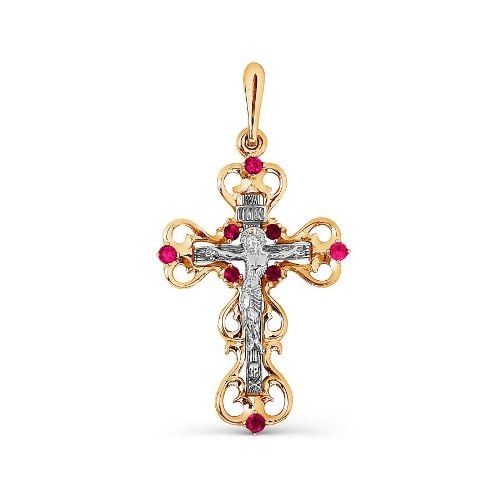
The cross must be consecrated in the church if it was purchased at a jewelry store. Consecration usually takes a couple of minutes. If he is bought in a shop that works at the church, then there is no need to worry about this, he will already be consecrated. Also, the church does not prohibit wearing crosses that were inherited from a deceased relative. There is no need to be afraid that in this way he will "inherit" the fate of his relative. V Christian faith there is no idea of inevitable fate (photo 4).

So, as already said, Catholic Church recognizes only the four-pointed shape of the cross. The Orthodox, in turn, is more forgiving and recognizes the six-pointed, four-pointed and eight-pointed forms. At the same time, it is believed that a more regular shape, still eight-pointed, with two additional partitions. One should be at the headboard, and the other for the legs (photo 5).

It is better for small children not to buy neck crosses with stones. At this age, they all try to try, they can bite off a pebble and swallow it. We have already noted that the Savior does not have to be on the cross. Also orthodox cross differs from the Catholic one in the number of nails for the feet and hands. So, in the Catholic creed there are three of them, and in the Orthodox - four (photo 6).
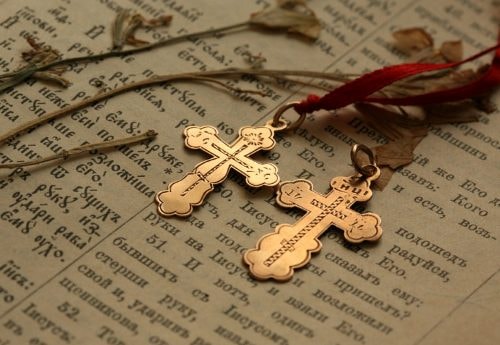
Note that, in addition to the crucified Savior, the cross can depict the face of the Mother of God, the image of Christ the Almighty. Various ornaments can also be depicted. All this does not contradict faith (photo 7).
